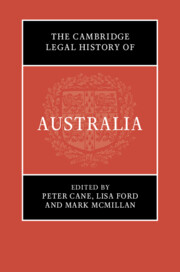Book contents
- The Cambridge Legal History of Australia
- The Cambridge Legal History of Australia
- Copyright page
- Contents
- Figures
- Maps
- Contributors
- Maps
- 1 Editors’ Introduction
- I Cultures of Law
- II Public Authority
- III Public Authorities in Encounter
- IV Land and Environment
- 13 Settlement and Dispossession
- 14 Australian Land Law
- 15 Aboriginal Land Rights, Subjection and the Law
- 16 Land Justice
- 17 Environment
- V Social Organisation
- VI Social Ordering
- VII Reckonings
- Index
14 - Australian Land Law
from IV - Land and Environment
Published online by Cambridge University Press: 04 August 2022
- The Cambridge Legal History of Australia
- The Cambridge Legal History of Australia
- Copyright page
- Contents
- Figures
- Maps
- Contributors
- Maps
- 1 Editors’ Introduction
- I Cultures of Law
- II Public Authority
- III Public Authorities in Encounter
- IV Land and Environment
- 13 Settlement and Dispossession
- 14 Australian Land Law
- 15 Aboriginal Land Rights, Subjection and the Law
- 16 Land Justice
- 17 Environment
- V Social Organisation
- VI Social Ordering
- VII Reckonings
- Index
Summary
Australian land law can now only be viewed through the prism of Mabo’s reframing of the history of land law to include First Nations’ law within its purview and to bring it and the colonising land law into relation with each other. Thus Mabo (and Wik) provide the framework for this chapter. The arrival of a foreign, colonising power in 1788 disrupted the complex systems of First Nations’ land law that had covered the Australian continent for millenia. The baggage of English land law including the feudal doctrines of tenure and estates became the law of the land and operated to dispossess but could not destroy First Nations’ land law and relationships. By the mid nineteenth-century, unique and significant departures from English land law and feudal doctrines emerged, reflecting the particular social, economic and geographical environment of the colonies: for example, the creation of pastoral leases, development of Crown reserves, the regulation of mining by way of leases and licences distinct from the common law and the creation of the unique title by registration scheme by Robert Torrens. Mabo’s reassessment of this “peculiarly Australian land law freed the law of some of its common law feudal origins, particularly by redefining the nature of Crown title. Paradoxically it also reinstated the prominence of the doctrines of tenure and estates as the land law’s “skeleton of principle” which remains the major impediment to a truly Australian land law.
Keywords
- Type
- Chapter
- Information
- The Cambridge Legal History of Australia , pp. 328 - 353Publisher: Cambridge University PressPrint publication year: 2022



